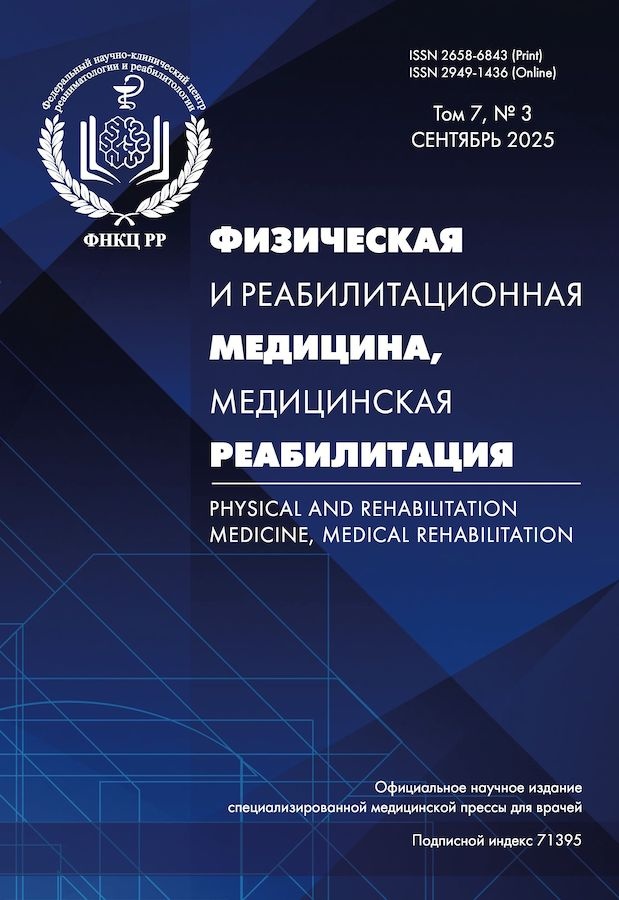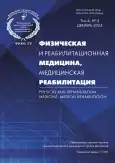Dynamics of emotional-cognitive and motor disorder domains in the Post Intensive Care Syndrome structure in acute cerebral insufficiency patients
- Authors: Belkin A.A.1, Belkin V.A.1, Vasilchenko I.E.1
-
Affiliations:
- Clinical Institute of Brain
- Issue: Vol 6, No 4 (2024)
- Pages: 348-359
- Section: ORIGINAL STUDY ARTICLE
- URL: https://journal-vniispk.ru/2658-6843/article/view/277519
- DOI: https://doi.org/10.36425/rehab635419
- ID: 277519
Cite item
Full Text
Abstract
BACKGROUND: The study of different drug therapies as an adjuvant component of rehabilitation for acute cerebral insufficiency patients has scientific and practical value.
AIM: This study investigates the efficacy and safety of sequential therapy with nervous system agents as part of a comprehensive rehabilitation program for acute cerebral insufficiency patients in relation to their impact on the severity of emotional-cognitive disorders, mobility, severity of the Post Intensive Care Syndrome, and delivering their rehabilitation potential.
MATERIALS AND METHODS: A randomized, prospective intervention study of 60 acute cerebral insufficiency patients divided into two groups included five visits. The study group received standard therapy and ethylmethylhydroxypyridine succinate (500 mg/day intravenously for 10 days) followed by ethylmethylhydroxypyridine succinate FORTE 250 (1 tablet 3 times/day for 8 weeks). The control group received only standard therapy during the same period.
RESULTS: Both groups showed comparable improvement in cognitive function based on the MoCA score (p <0.001). The study showed a significant anxiety reduction based on HADS score at visit 4 in the study group versus the control: HADS scores of 2 [1; 4] and 5 [2.25; 7], respectively (p <0.01). The study showed a significant increase in Rivermead Mobility Index scores in both groups at all stages of the study (p <0.001); the median value in the study group exceeded the control group by 3 by visit 5 (p <0.001). Vital signs based on the Rehabilitation Routing Scale (RRS; p = 0.053) in the study group tended to be better versus the control. In addition, the number of disabled patients in the study group was significantly lower (RRS score ≥3) versus the control by visit 5 (Yates χ2 = 4; p = 0.045). Patients in both groups showed mild Post Intensive Care Syndrome with a downward trend of the number of patients in the study group between the 3rd and the 5th visit versus the control (Yates χ2 = 3.491; p = 0.062). At visit 5, a relationship of RRS scores and Rivermead Mobility Index scores was determined in patients of both groups (p <0.05), and RRS and MoCA scores in patients of the study group (p <0.01). No adverse events were observed during the study.
CONCLUSION: The study shows the beneficial effect of sequential therapy with nervous system agents as part of a comprehensive rehabilitation program for acute cerebral insufficiency patients on their emotional and cognition status, degree of disability, mobility, Post Intensive Care Syndrome severity, and recovery potential. The high degree of safety of the studied regimen was proven.
Full Text
##article.viewOnOriginalSite##About the authors
Andrey A. Belkin
Clinical Institute of Brain
Author for correspondence.
Email: belkin@neuro-ural.ru
ORCID iD: 0000-0002-0544-1492
SPIN-code: 6683-4704
MD, Dr. Sci. (Medicine), Professor
Russian Federation, BerezovskyVladimir A. Belkin
Clinical Institute of Brain
Email: vbelkin@neuro-clinic.ru
ORCID iD: 0000-0002-4043-743X
SPIN-code: 4402-0608
Russian Federation, Berezovsky
Igor E. Vasilchenko
Clinical Institute of Brain
Email: ivasilchenko@neuro-clinic.ru
ORCID iD: 0009-0007-2133-5626
Russian Federation, Berezovsky
References
- Zadvornov AA, Grigoriev EV. Extracerebral manifestations of acute cerebral insufficiency in patients in critical condition. Fundamental Clin Med = Fundamental’naya i klinicheskaya medicina. 2022;7(3):64–73. EDN: QYUUEL doi: 10.23946/2500-0764-2022-7-3-64-73
- Gelfand BR. Intensive care. Ed by B.R. Gelfand, I.B. Zabolotskikh. Moscow: GEOTAR-Media; 2017. 928 p. (In Russ.)
- Belkin AA, Zislin BD, Avramchenko AA, et al. Acute cerebral insufficiency syndrome as a concept of neu-roreanimatology. Anesteziologiya i reanimatologiya = Russ J Anaesthesiol Reanimatol. 2008;(2):4–8. EDN: JSBILR
- Belkin AA, Krylov BB, Piradov MI, Petrikov SS. Neurological diagnosis in diseases and injuries of the central nervous system. Intensive care. National Guidelines. Brief edition. Ed. by B.R. Gelfand, I.B. Zabolotsky. 2nd ed. Moscow: GEOTAR-Media; 2019. Р. 251–281. (In Russ.)
- Zhivolupov SA, Voznyuk IA, Samartsev IN, et al. Adaptive neuroplasticity after ischemic brain damage and its contribution to the recovery of patients after stroke: Theoretical prerequisites for effective neuroreabilitation. Effective Pharmacotherapy. 2020;16(31):24–38 EDN: KZFEOM doi: 10.33978/2307-3586-2020-16-31-24-38
- Shagaeva KA, Shagaev AS. Neuroplasticity mechanisms and prospects for personalized rehabilitation strategies in patients with motor and cognitive impairments. Bulletin Rehabilitat Med = Vestnik vosstanovitelʹnoy mediciny. 2021;20(5):37–46. EDN: DZXIEI doi: 10.38025/2078-1962-2021-20-5-37-46
- Shulyndin AV, Antipenko EA. Specific features of rehabilitation potential in adult patients with cerebral palsy. Saratov J Med Sci Res. 2019;15(1):187–190. EDN: MMXWIU
- Yu SS, Shmonin AA, Verbitskaya EV, et al. Research of the factors that determine the rehabilitation potential and satisfaction of the medical care of patients with acute stroke in China and Russia. Regional Blood Circulation Microcirculation. 2016;15(4):82–88. EDN: YGWLFL doi: 10.24884/1682-6655-2016-15-4-82-88
- Khasanova DR, Magsumova RL, Danilova TV. System of autonomic balance in ischemic stroke acute period and its influence on rehabilitatiob potential. Consilium Medicum. 2020;22(2):13–18. EDN: ENFZXY doi: 10.26442/20751753.2020.2.200030
- Kazakov NP, Abramovich SG, Knyazyuk OO, Mikhalevich IM. Rehabilitation potential of patients with ischemic stroke: the possibility of predicting the course of the disease and the results of rehabilitation treatment. Voprosy kurortologii, fizioterapii i lechebnoi fizicheskoi kultury = Problems Balneol Physiother Exercise Ther. 2022;99(2):13–22. EDN: EPKYLF doi: 10.17116/kurort20229902113
- Alieva AD. Cognitive dysfunction, anxiety and depression and the rehabilitation potential of patients who have suffered an ischemic stroke: Problems and prospects. In: Stroke and vascular diseases of the brain: Materials of a scientific and practical seminar dedicated to the World Day against stroke, Makhachkala, 2018 October 29. Ed. by B.A. Abusueva. Makhachkala; 2018. P. 16–18. (In Russ.) EDN: YPJBFR
- Hackett ML, Yapa C, Parag V, Anderson CS. Frequency of depression after stroke: A systematic review of observational studies. Stroke. 2005;36(6):1330–1340. doi: 10.1161/01.STR.0000165928.19135.35
- Belkin AA, Alasheev AM, Belkin VA, et al. Rehabilitation in the intensive care unit (rehablcu). clinical practice recommendations of the national union of physical and rehabilitation medicine specialists of Russia and of the national Federation of anesthesiologists and reanimatologists. Russian Federation of anesthesiologists and reanimatologists guidelines. Alexander Saltanov Intensive Care Herald. 2022;(2):7–40. EDN: MEUVHV doi: 10.21320/1818-474X-2022-2-7-40
- Belkin AA. Syndrome effects of intensive therapy: Post Intensive Care Syndrome (PICS). Alexander Saltanov Intensive Care Herald. 2018;(2):12–23. EDN: XUAIUH doi: 10.21320/1818-474X-2018-2-12-23
- Belkin AA, Belkin VA, Vasilchenko IE, Pinchuk EA. Results of a cohort single-center randomized study of the modulating effect of the drug Mexidol in the rehabilitation of patients who suffered acute cerebral insufficiency. S.S. Korsakov J Neurology Psychiatry. 2024;124(4):108–117. EDN: CVLEDT doi: 10.17116/jnevro2024124041108
- Voronina TA. Mexidol: The spectrum of pharmacological effects. S.S. Korsakov J Neurology Psychiatry. 2012;112(12):86–90. EDN: PTUPBT
- Shchulkin AV. A modern concept of antihypoxic and antioxidant effects of Mexidol. S.S. Korsakov J Neurology Psychiatry. 2018;118(12):87–93. EDN: PPTGEP doi: 10.17116/jnevro201811812287
- Voznyuk IA, Kolomentsev SV, Morozova EM. The impact of therapy with Mexidol on neurological deficit and functional outcome in patients with ischemic stroke: A systematic review and meta-analysis. S.S. Korsakov J Neurology Psychiatry. 2023;123(12-2):49–60. EDN: ZDQAXU doi: 10.17116/jnevro20231231221
- Martynov MU, Zhuravleva MV, Vasyukova NS, et al. Oxidative stress in the pathogenesis of stroke and its correction. S.S. Korsakov J Neurology Psychiatry. 2023;123(1):16–27. EDN: VPHPBW doi: 10.17116/jnevro202312301116
- Chefranova ZY, Makotrova TA, Udachin VA, Koledintseva EV. Efficacy of Mexidol in the combination with thrombolytic therapy in patients with ischemic stroke. S.S. Korsakov J Neurology Psychiatry. 2012;112(4):49–52. EDN: PBZFIF
- Belkin AA, Rudnik EN, Belkin VA, et al. Development and validation of the PICS-index to assess the severity of the syndrome of consequences of intensive care: A descriptive, prospective, and unmatched cohort study. Alexander Saltanov intensive care herald. 2024;(4):58–72. EDN: JPUJCG doi: 10.21320/1818-474X-2024-4-58-72
Supplementary files













